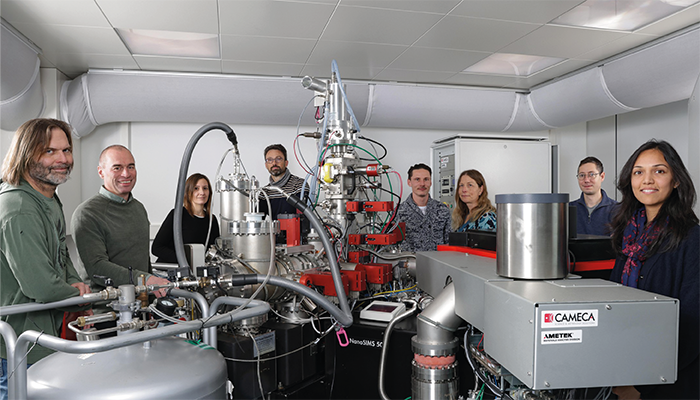
The research team in front of the CryoNanoSIMS instrument.
Credit: 2025 EPFL/Alain Herzog - CC-BY-SA 4.0
Researchers have used an advanced cryogenic imaging method to reveal how plants respond to high salt levels, providing the first direct visualization of how sodium is managed at the cellular level. The study, published in Nature, demonstrates how the “Salt Overly Sensitive 1” (SOS1) transporter protein plays a key role in protecting plant cells by sequestering excess sodium into vacuoles.
Using cryogenic nanoscale secondary ion mass spectrometry (CryoNanoSIMS), the team from EPFL and the University of Lausanne (UNIL), Switzerland, mapped the distribution of sodium, potassium, and other essential ions in plant root cells under varying salt stress conditions. “Our research provides the first visual proof, at the cellular scale, of how plants protect themselves against excess of sodium,” said Priya Ramakrishna, lead author and postdoctoral researcher at EPFL, in a press release.
Under mild salt stress, the study found that root cells prevent sodium from accumulating in the cytoplasm. However, under higher salt concentrations, the SOS1 protein helps sequester sodium into vacuoles, specialized organelles that store unwanted compounds. This process, while protective, is energy-intensive and can limit plant growth over time.
The study also examined root cells from mutant plants lacking the SOS1 transporter. These cells were unable to store sodium in vacuoles, confirming the crucial role of SOS1 in salt tolerance. Similar results were observed in rice, suggesting that this mechanism is evolutionarily conserved across plant species.
The CryoNanoSIMS technique provided unprecedented detail, with a resolution of 100 nanometers, enabling researchers to track the movement of sodium and other elements within individual cells. “With this kind of truly interdisciplinary collaboration, blending biology and engineering, we can match location with function and understand mechanisms and processes that have never been observed before,” said corresponding author Anders Meibom from EPFL and UNIL.
Prior to this study, researchers had assumed SOS1 primarily functioned at the plasma membrane by expelling sodium from cells. The findings challenge this view by showing that SOS1 also localizes to the vacuolar membrane, helping to store sodium internally rather than exporting it out of the cell. This discovery helps to explain why some plants exhibit greater salt tolerance than others and opens new possibilities for breeding salt-resistant crops.
“Plants are fundamentally dependent on extracting mineral nutrients from the soil, but we were never able to observe their transport and accumulation at sufficient resolution,” said Niko Geldner, co-corresponding author and leader of the UNIL research team. “The CryoNanoSIMS technology finally achieves this and promises to transform our understanding of plant nutrition, beyond the problem of salt.”
Future research will aim to explore how different plant species regulate the SOS1 transporter and whether similar mechanisms could be leveraged to enhance crop resilience to environmental stress. “This technique is opening up an entirely new horizon in the imaging of biological tissue,” added Christel Genoud, co-author and Director of the Dubochet Center for Imaging.
With soil salinization affecting up to 40 percent of arable land worldwide, the study’s findings could help guide agricultural strategies to combat the negative impact of rising soil salt levels on food production.




